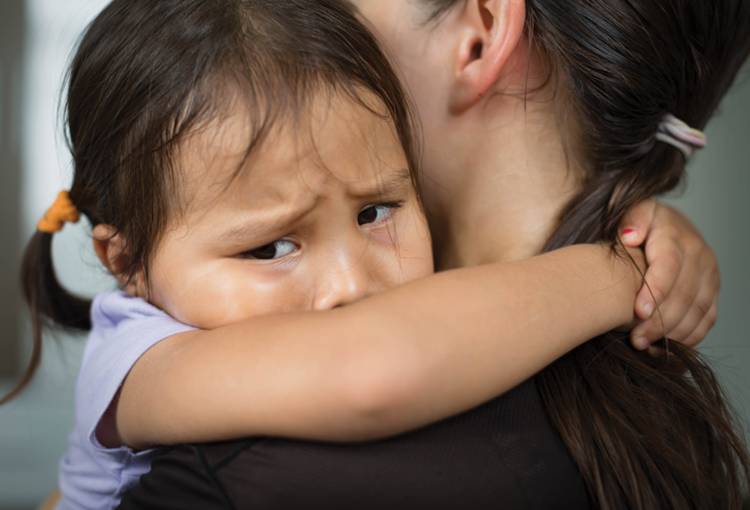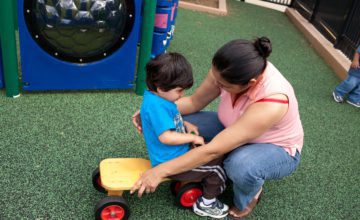Self-regulation is influenced by external factors like the environment and interactions with others and by internal factors such as temperament. The particular temperament children are born with impacts how easily they are able to regulate themselves.
Two-month-old Daryl cries softly as he wakes up from his nap. Jodi, his teacher, calls to him, saying, “I hear you, Daryl. Miss Jodi is coming as soon as she washes her hands.” Daryl quiets.
Four-month-old Charlotte rubs her eyes and begins to whimper. Her teacher, Jan, says, “You’re getting tired, aren’t you?” Jan sits in a rocker and begins to rock and hum to Charlotte. Charlotte calms, and Jan places her in her crib, gently patting her tummy before walking away. Charlotte fusses just for a minute before drifting off to sleep.
Ten-month-old Bess is sitting with a shape sorter. She is concentrating and trying very hard to push the round shape into the square hole. Vivian, her family child care provider, sits nearby, tending to a crying baby. Bess looks at the baby, catches Vivian’s eye, then goes back to concentrating on the shape-sorting task. A few minutes later, Bess moves her shape to the round hole and it falls in. Bess looks up and Vivian smiles: “You did it!” Bess smiles at Vivian before picking up the next shape.
Thirty-month-old Shane has the toy camera, one of the children’s favorite toys in the classroom. Kayla comes over and tries to take it out of his hands, and Shane pulls it away. Liz, their teacher, squats down and says to Shane, “Remember when Kayla was playing with that camera yesterday and you really wanted it? That’s how she feels now—she really wants it. Will you give it to her when you are done playing with it?” Shane looks at his teacher, then at the camera, and then at his friend Kayla. A few minutes later he takes the camera over to Kayla. “Thank you, Shane, that was very kind of you,” Liz says.
Each of these adults is facilitating the development of self-regulation, or the “conscious control of thoughts, feelings, and behaviors” (McClelland & Tominey 2014, 2). Another way of thinking about self-regulation is as a person’s ability to manage attention and emotions well enough to complete tasks, organize behavior, control impulses, and solve problems constructively (Murray et al. 2015). When children struggle with self-regulation, it is difficult for them to sit still, concentrate, and participate in learning activities.
Each of the educators above is supporting self-regulation skills by co-regulating with the children they care for. Co-regulation is defined as warm and responsive interactions that provide the support, coaching, and modeling children need to “understand, express, and modulate their thoughts, feelings, and behaviors” (Murray et al. 2015, 14). Co-regulating requires teachers and providers to pay close attention to the cues children send and respond consistently and sensitively over time with just the right amount of support. Let’s take a closer look at these emerging self-regulation skills and how they are supported and nurtured from infancy onward.
In the beginning, very young children’s capacity for self-regulation is limited, and they are very dependent on their teachers for co-regulation. For those working with infants and toddlers, warm and responsive interactions are truly foundational for the development of self-regulation—as we see in the examples with Daryl and Charlotte. The teachers’ prompt and caring interactions support each baby’s ability to begin to self-regulate and manage the tasks of waiting, self-soothing, and transitioning between activities. In these examples, Daryl is able to wait while Jodi finishes washing her hands, and Charlotte learns to soothe herself to fall asleep. Both babies have learned over time that their teachers will be there to offer support, if and when they need it.
When children’s needs are met in this way, the children grow to learn that they can trust the adults in their world to care for them. Having the expectation that their needs will be met allows infants to relax their demands and begin to develop self-soothing skills, like sucking on their fingers or thumbs, twisting their hair, and so on. Learning to self-soothe is a trial-and-error process as babies test ways to calm themselves. They continue to need adult assistance with soothing and regulating, especially when in stressful situations, but their dependence on others for help lessens as they get older. Learning self-regulation skills by experiencing tuned-in caregiving in early childhood is very important, as it is linked to greater success both academically and socially, through adulthood (Raby et al. 2015).
Children use their growing ability to self-regulate in more complex ways over time. Look at Bess as she concentrates on putting the shape into the correct hole. She is exercising the cognitive aspect of self-regulation as she directs her attention to the task at hand. Bess uses her relationship with Vivian as a secure base when the challenge of this task approaches frustration. She briefly turns her attention to Vivian for support and is then able to return to her task.
At 30 months, we see Shane beginning to demonstrate understanding of his friend Kayla’s feelings. The relationship with Liz and her nurturing support help Shane make the connection between his own feelings and those of his friend—which is the root of empathy. His teacher, Liz, has acted as a bridge to assist Shane in this developmentally challenging task. This type of social-emotional learning can happen only in a supportive, nurturing environment where children feel safe and valued and where their needs are met consistently.
Self-regulation is influenced by external factors like the environment and interactions with others and by internal factors such as temperament. The particular temperament children are born with impacts how easily they are able to regulate themselves. Children also exhibit differences in emotional intensity—or how strongly they experience and express their feelings. We notice that children at very early ages respond differently to stimuli such as light, noise, scent, touch, and temperature. Children also differ in their ability to manage change and transitions. These are just a few of the differences among children that teachers may encounter. Each requires a calibrated response that matches the needs and temperament of the individual child. When teachers co-regulate, or tune their responses to the various needs of individual children, they support the skill of self-regulation in a group setting.
Here are some tips to promote self-regulation in very young children:
- Create an environment where each child can form a long-term, trusting relationship with a teacher she knows well. Adopt a primary caregiving system in which each adult is responsible for a small number of children.
- Provide responsive, consistent, and nurturing care. When you are responsive, you teach young children that their needs and preferences matter. When you are consistent, you teach young children they can trust others. When you are nurturing, you teach young children that relationships with others should feel comforting and joyful.
- Promote critical thinking by creating an environment where children feel safe to explore and are comforted if they become confused or scared. “Positive control, autonomy support, and responsiveness have been most often linked to the development of strong self-regulation skills in the research literature” (McClelland & Tominey 2014, 5).
- Model your ability to self-regulate. As adults, we need to exercise our own self-regulatory skills to co-regulate with the children we care for. When we find ourselves feeling overwhelmed, angry, or burned out, we need to learn healthy ways to manage these strong feelings. When we feel calm and even-keeled, we do a better job of supporting the children in our care.
Think About It
- Reflect on your ability to regulate your own thinking and emotions. How does that ability change over the course of the day?
- What might cause that ability to change?
- Think about a time you noticed a baby’s or toddler’s cues. How did you use this as an opportunity to co-regulate?
Try It
- Pay attention and respond to each child’s individual cues, and ask parents how they observe their children communicating needs.
- Talk to children during the daily routines and experiences of each day, and describe to them what you are doing and how they are responding.
- List some of the strategies you use to co-regulate with the children in your care, and share them with your colleagues or supervisor.
- Take the time to sensitively respond to the individual children in your care. Doing so not only makes your job fascinating and rewarding, it also contributes to children’s learning the lifelong skill of self-regulation.
References
McClelland, M.M., & S.L. Tominey. 2014. The Development of Self-Regulation and Executive Function in Young Children. Washington, DC: ZERO TO THREE.
Murray, D.W., K. Rosanbalm, C. Chrisopoulos, & A. Hamoudi. 2015. Self-Regulation and Toxic Stress: Foundations for Understanding Self-Regulation From an Applied Developmental Perspective. OPRE Report #2015-21. Washington, DC: Office of Planning, Research and Evaluation, Administration for Children and Families, US Department of Health and Human Services.
Raby, K.L., G.I. Roisman, R.C. Fraley, & J.A. Simpson. 2015. “The Enduring Predictive Significance of Early Maternal Sensitivity: Social and Academic Competence Through Age 32 Years.” Child Development 86 (3): 695–708.
Copyright © 2015 by the National Association for the Education of Young Children. See Permissions and Reprints online at www.journal.naeyc.org/about/permissions.asp





